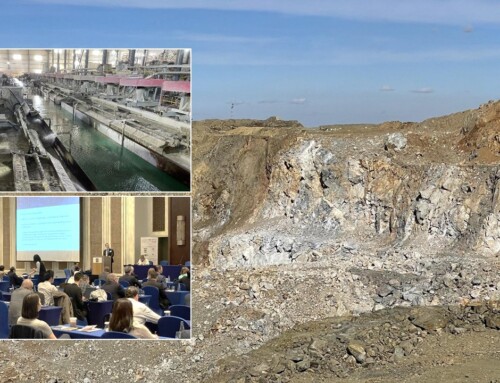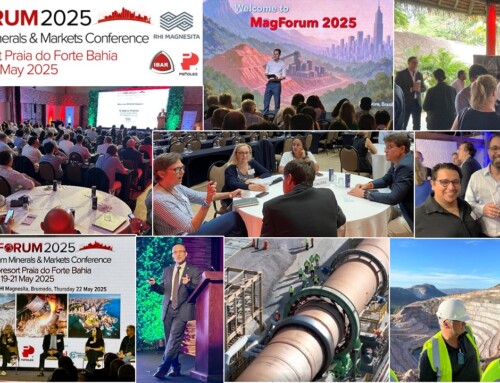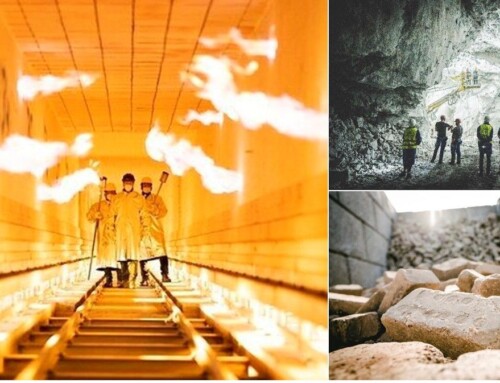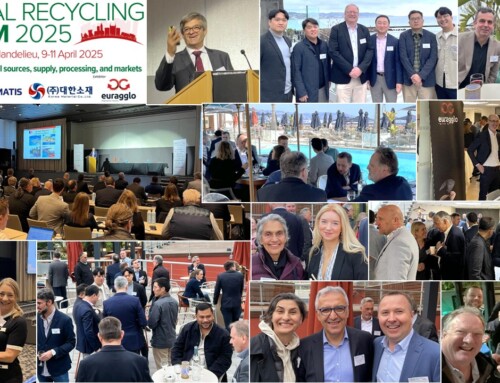MagForum 2018 Review
The great and the good of the global magnesia business gathered at IMFORMED’s MagForum 2018 conference held 17-20 June, at the Grande Elysée Hotel, Hamburg.
And what a superb MagForum it turned out to be, the largest yet with 230 international attendees networking and discussing the key issues influencing the industry, stimulated with a diverse programme presented by leading experts.
MagForum 2019 Bilbao
13-15 May 2019, Occidental Bilbao
Early Bird Rates | Book Now!

The benchmark was set high from the start with RHI-Magnesita’s wonderful Welcome Reception at the Heritage, Le Méridien Hotel, offering delegates fine dining and a breath-taking view over Hamburg’s Alster Lake.
Home to speciality magnesia supplier Lehmann&Voss&Co., and as lead sponsor of MagForum 2018, it was fitting that Knut Breede, Managing Partner, formally opened proceedings with a Welcome Address providing not just an insight to Lehmann&Voss but also the longstanding pedigree of Hamburg as a mineral trading hub.
“MagForum is an excellent networking event. It’s always an opportunity to meet and talk with peers to see what’s happening in the magnesia world. Excellent, varied programme – the roundtable session was an excellent initiative.”
Anthony McEneaney, Project Manager, RHI Magnesita, Ireland“I would like to congratulate you for the superb conference. I have enjoyed the great level of valuable information shared on all technical presentations. Organisation excelled again, in a nice city, nice hotel.”
Emílio Lobato, Commercial Director, IBAR Nordeste Ltda, Brazil“Good programme and roundtable session. Don’t see how it could be improved.”
Chris Wragg, Group Supply Chain Manager, Capital Refractories, UKFor more feedback, pictures, and summary slide deck please go to: MagForum 2018
2017 a game-changing year
Mike O’Driscoll, Director, IMFORMED, presented an overview of the magnesia industry and highlighted some key talking points: China – supply shortages, rising prices, reforms, what’s next?; M&A activity – RHI Magnesita, TIMAB/Magna, Afarak/Magnohrom, Kumas for sale; potential new sources – Serbia, Greece, Turkey, Australia, Jordan, Pakistan; diversification into non-refractory markets.
O’Driscoll urged that the industry should consider 2017 be seen as a game-changing year, with 2018/19 to have continued tight supply and high prices, prolonged with closures owing to dynamite provision uncertainty, MEE inspections (environment and safety), and business practice audits.
Most recent developments now include China Customs trade audits, demanding importers’ declaration of consignment details – ie. comparing export and imports as part of controlling smuggling.
There is increased likelihood of state-control of the supply sector, although this needs finalisation and proving, and of annual enforced plant closures Oct-Mar. as anti-pollution control, which will probably influence buying patterns, and perhaps a future new “cycle” of production and buying will evolve during the July-Sept. period.
There is also the potential of a trend in the “transfer” of some Chinese production capacity overseas and/or Chinese suppliers setting up facilities overseas to supply China and world markets.
The upshot is that the situation has boosted prospects for and interest in magnesia projects and sources outside China, and given refractory recycling more impetus.
Find out all about the latest Chinese developments at
China Refractory & Abrasive Minerals Forum 2018
10-12 September 2018, Shanghai
CONFIRMED SPEAKERS | FIELD TRIP TO CMP BAUXITE GUIZHOU
Book Now! Early Bird Rate saving US$300 ends 3 August 2018
Keynote Discussion Panel
The now established and acclaimed MagForum Keynote Discussion Panel got straight to the heart of matters during the first morning with the influence of ongoing issues in China very much to the fore.

Moderated by Mike O’Driscoll, IMFORMED, the panellists were (from left in above picture): Rainer Gaebel, Managing Director, Refratechnik Holding GmbH, Germany; Jürgen Mannshardt, Director Business Unit Magnesia, Lehmann&Voss&Co.KG; Michael Tsoukatos, Business Dev Manager Grecian Magnesite SA, Greece; Ted Dickson, Consultant, TAK Industrial Mineral Consultancy, UK; Rajah Jayendran, Snr VP, Head of Operations Europe 2, RHI Magnesita, Austria
Gaebel noted that it was a key moment in the market, where customers must be kept happy despite perhaps not enough raw material available, while R&D efforts must continue for planning in the long term for added value products. Raw material distribution channels are changing he said.
Mannshardt warned of a future loss of raw material production capacity in China that will not be returning, and while he expected a further 1-2 years of disruption in the market owing to changes, he was confident that sufficient volumes would be available after that period.
Tsoukatos acknowledged the tight supply of high purity dead burned and fused magnesia and said that the industry needed to react to the situation, underlining the importance of new product development. He also forecast further mergers and acquisitions in the industry.
Dickson pointed out that the primary magnesia consuming industries were actually performing well at present. He highlighted how many end users were over-reliant on Chinese magnesia supply and that a “new normal” would soon emerge whereby consumers would be wary of Chinese supply and will diversify their sources. He forecast a surge in innovation in refractory products that will indicate a step-change.
Jayendran remarked that in fact China has been building towards its present clampdown on pollution and illegal businesses for some time, and this should not have come as a surprise.
RHI Magnesita, China, and source options outside China
In “The driving force of the refractory industry: a world market leader emerges”, Thomas Frömmer, Vice President Mining, Head of Raw Material Support, RHI Magnesita reviewed the portfolio and strategy of the group nine months on from the mighty merger.
The group produces 1.6m tpa of refractory raw materials and is 70% vertically integrated in basic raw materials and 50% for all other raw materials. Frömmer revealed that the Norwegian fused magnesia plant, Normag, would be ramped up to full capacity by the end of 2018.

He also indicated that the group was investing further in China (this bore fruit just after MagForum 2018 on 26 June when RHI Magnesita announced a >€20m investment in its refractory grade dolomite plant in Chizhou, Anhui province)
“China: its role and influence on the magnesia market” by Alison Saxby, Director, Roskill Information Services Ltd, & Ted Dickson, TAK Industrial Minerals Consultancy examined the historical global perspective, Chinese influence on production, Chinese influence on trade, growth of domestic markets in China, and Chinese government policy shaping the future.
Dickson noted that among the ramifications of China’s changing magnesia sector, the enforced switch to gas fuel for some producers will be difficult owing to infrastructure, and there was potential for “synthetic magnesia production” in China from brine sources or development of new processing technology.
It is expected that there will be more focus by Chinese producers to satisfy domestic demand rather than export markets.

Dickson concluded that “China will continue to lead the magnesia industry in terms of production, demand, and trade. It will take at least two years for a new landscape to emerge, when the medium to longer term picture will become clearer.”
“Magnesite beyond China: potential alternative sources” by Dr Ian Wilson, Consultant, was an excellent review of the status and developments for various magnesia sources outside China, namely in Russia, Brazil, Turkey, Pakistan, Australia, and North Korea.
Regarding Magnezit’s plans, its Magnezitovaya mine at Satka is looking to expand magnesite mining capacity to 1.6m tpa by 2029; other planned milestones include a 15,000 tpa increase in fused magnesia (FM) capacity in Satka in 2018, followed by a further 50,000 tpa in 2019, and at its Lower Angara site, an additional 50,000 tpa in 2023. A 100,000 tpa 2-step high purity dead burned magnesia (DBM) plant is planned at Satka in 2020.
In Brazil, IBAR Nordeste’s plans for 2019 include a new rotary kiln (the fourth), a new MHF for calcining in combination with a shaft kiln for sintering, and a flotation project for high purity MgO (min. 96.5%) targeting both CCM and DBM markets.

In Turkey, Akdeniz Mineral Kaynaklari is to increase its CCM capacity (currently 36,000 tpa) by 30,000 tpa. Turkmag’s 2018 production is estimated at 90,000 tonnes DBM and 240,000 tonnes magnesite, and the company has an investment plan for a second new rotary kiln in 2019-2020.
Wilson also profiled some interesting new developments with sources in Afghanistan and Pakistan, including two new companies entering the market: Master Minerals and Galaxy Enterprises.
Roundtable Networking Session a hit
The new post-lunch Roundtable Networking Session was extremely well received and supported by delegates as they sought to share and gain informed comment on the leading topics of day in an informal and convivial environment.

Outside China: Iran, Saudi Arabia, Morocco, Russia & Japan
“New magnesite resources in Iran” by Dr Ali Reza Ganji, Industrial Minerals Specialist, examined Iran’s geology, magnesite ore geology, mining, and new resources.
The geological setting of Iran’s magnesite deposits is along or adjacent to active faults. Iran hosts 4.7m tonnes proven reserves and 7.1m tonnes probable reserves of magnesite and there are 47 active, 15 inactive, 3 planned magnesite mines.

Total production capacity is 280,000 tpa magnesite, although 2016 production was 145,223 tonnes.
“Recently, more than 3.3 and 2.5 million tonnes of stockwork type magnesite proven reserves have been discovered in the Sistan va Balouchestan and South Khorasan provinces, respectively.” said Ganji. The total amount of estimated reserves of these new resources could be more than 15m tonnes.
“MENA magnesite and dolomite developments” by Nicholas Gangutia, Ganmag Magnesite Solutions, updated delegates with Maaden’s DBM project, as well as introducing a new dead burned dolomite operation in Spain and potential sources of magnesite and dolomite in Morocco.
Gangutia reported on the successful start-up last year of the 32,000 tpa DBM plant using the direct sintering shaft kiln, with production sold out on spot prices. Reserve estimates have also increased to 4m tonnes.

“Due to its high chemistry and density, Maaden is selling high grade DBM for refractory bricks market. Hard burned CCM is being used as raw material for FM. All MgO < 94% or low density DBM is used for refractory masses production.” said Gangutia.
Gangutia also notified delegates about the successful start up of a new vertical shaft kiln in Spain for the production of dead burned dolomite and introduced Magnésie du Rif, developing magnesite and dolomite deposits in northern Morocco.
Henk Don, Managing Director, Europiren BV, presented “Russian brucite mining, processing, and market applications” highlighting the history of the Kuldur brucite deposit, which is one of the world’s largest brucite deposits with confirmed reserves of more than 10m tonnes and current output of around 300,000 tpa of all grades.

Don announced that development of the recently acquired Savkinsky brucite deposit, 80km from Kuldur, would commence in Q3 2018, increasing total production by 200,000 tpa and will be operational in 2023.
A third processing plant will officially be opened on 12 July 2018 at RMCC’s Vyazma brucite processing facility 240km west of Moscow, increasing the total capacity for milled brucite by 50% to 150,000 tpa.
 “A sea change & new challenges in magnesia” introduced by Kenji Fujimoto, General Manager, Magnesia Division, Ube Material Industries Ltd, outlined two very interesting new applications for magnesium hydroxide in Japan: the suppression of H2S gas generation creating road collapse (presented by Atsushi Kondo), and the effect of Mg(OH)2 in assisting swimming pool algae clean-up (presented by Koki Takahashi).
“A sea change & new challenges in magnesia” introduced by Kenji Fujimoto, General Manager, Magnesia Division, Ube Material Industries Ltd, outlined two very interesting new applications for magnesium hydroxide in Japan: the suppression of H2S gas generation creating road collapse (presented by Atsushi Kondo), and the effect of Mg(OH)2 in assisting swimming pool algae clean-up (presented by Koki Takahashi).
The day was rounded off in exceptional style with the excellent Lehmann&Voss&Co. reception at the Au Quai Restaurant on the Elbe – via a lovely guided bus tour – a fabulous setting for delegates to unwind and network, take in the views, as well as a few local cocktail specialities, and some very enthusiastic singing and inventive dancing late into the night.
Out now! Magnesia World Sources Map
Contact Ismene ismene@imformed.com | +44 (0)7905 771 494
Magnesia refractories, salts, & chemicals
“High quality sintered magnesia and doloma for refractories” by Asim Bilge, Sales Specialist, Kümaş Refractories, detailed Kümaş, the magnesia market, magnesia products, the sinter process, sintered magnesia, and sintered doloma. 
Kümaş’ magnesite sources have a well-known reputation internationally with high purity and cryptocrystalline structure and the company consumes some 1.2m tpa magnesite.
Bilge explained that doloma is used if the deoxidation agent is silicon in the steelmaking process, since it creates a protective layer on the refractory brick surface.
 “Magnesium salts and markets outlook” by Johannes Bode, Head of Marketing & Product Management, K+S, reviewed the group’s impressive 9m tpa production capacity of potash and magnesium salts and their respective markets.
“Magnesium salts and markets outlook” by Johannes Bode, Head of Marketing & Product Management, K+S, reviewed the group’s impressive 9m tpa production capacity of potash and magnesium salts and their respective markets.
K+S operates seven production sites in Germany, although the magnesium sulphate Sigmundshall mine is earmarked for closure.
K+S has strengthened its specialities division and improved access to growth markets of South East Asia and China with the acquisition of Huludao Magpower Fertilizers Co., China, one of the largest producers of synthetic magnesium sulphate (SMS) used as fertiliser for oil palms, soybeans and sugar cane as well as for industrial applications.
In “High value magnesia markets”, Samantha Wietlisbach, Principal Analyst Chemicals, IHS Markit, analysed the flame retardant and other high value markets of magnesia and magnesium hydroxide (MDH). 
Looking at the world CCM market, estimated at 4m tonnes in 2017, Wietlisbach explained how construction is the main segment with 39%, while environmental uses, such as in flue gas desulphurisation (FGD) consumes around 11%.
Smaller volume but higher value markets include transformer steel and catalysts in western Europe, and fluoroelastomers and neoprene in North America.
Polyolefins, which now account for over half global plastic demand, are one of the leading consumers of MDH flame retardants. The mineral flame retardants market is growing annually at about 3.6% to 2021.
Steven Green, General Manager, Sales and Business Development, Protea Mining Chemicals, soon had everyone’s attention to his paper “Magnesia additives used in mineral processing” by offering a prize of a latest generation Wi-Fi speaker if a delegate could explain the relationship between the mobile phone controlled speaker and magnesia additives for mineral processing.

The answer of course was in Green’s excellent insight into how magnesia chemicals are used to assist in the processing of cobalt and nickel ores, their respective derivative hydroxides being a vital component in the new generation of Li-ion batteries used to power mobile phones and other modern devices.
A typical specification for MgO used in such processing applications is 96.5 MgO, 2.3% CaO, 1.2% SiO2, 0.2% Fe2O3, 0.1% Mn3O4.
Processing developments
“Serpentine: today’s by-product, tomorrow’s raw material source” by Beyhan Ozdemir, Managing Director, Mavi Prizma, assessed the potential of utilising serpentine waste from magnesite mining. 
In Turkey, to produce 1 tonne of magnesia, about 2.1-2.4 tonnes of magnesite is mined, which yields some 55 tonnes of serpentine waste. Approximately 40m tpa of serpentine, a hydrated magnesium silicate, is produced in Turkey.
Potential market applications include as a flux material for blast furnace instead of olivine (to adjust alkalinity); hydrometallurgy; refractories; cordierite ceramics; and cement and concrete.
 Jens-Michael Bergmann, Sales Manager Europe/MENA/India, Tomra Sorting Solutions, presented “Can dry sensor sorting substitute DMS in raw magnesite beneficiation? Technical approach and field experiences.”
Jens-Michael Bergmann, Sales Manager Europe/MENA/India, Tomra Sorting Solutions, presented “Can dry sensor sorting substitute DMS in raw magnesite beneficiation? Technical approach and field experiences.”
Bergmann explained the sensor approach in mineral ore processing, including belt and chute systems, before going on to highlight the different modes of sensors: electromagnetic, near infra-red (NIR) spectrometry; x-ray transmission (XRT); colour; and laser reflection.
In sorting magnesite ore, Bergmann concluded that removal of calcite, dolomite, or quartz, when similarly coloured, can be a problem for a colour-only device, but combination with NIR is a field-proven solution.
Since silicon is a challenge for NIR, especially if the Si is finely disseminated inside the particles, the XRT-Sorter is the best solution for SiO2 removal.
“Mineral processing technology for magnesia & dolomite” by Jan Lampke, Senior Process Engineer – Mineral Processing, Haver Engineering GmbH reviewed the elements of efficient mineral processing based on industrial case studies using screening, washing, pelletising, and process development and optimization with NIAflow – a simulation software used in mineral processing.
The attributes of employing a good pelletising system include: improved storage and transport properties; defined grain size and grain shape; generation of narrow grain size distribution; avoidance of product segregation; defined porosity and density; improved permeability; increased market value and market potential.
Field Trips: CTP & K+S, Hamburg Port
The conference concluded with two excellent site visits: first on Tuesday afternoon a fine tour of Hamburg container port before arriving at the impressive nautically designed head office of CTP.BIZ.GmbH in Rellingen, where Capt. Thomas Pötzsch addressed delegates on CTP’s role in mineral shipping before hosting a tour of the building which included an exquisite selection of maritime instruments, and a superb reception on the roof terrace.


Second, on Wednesday morning was a visit to K+S’s Kalikai via a boat tour of Hamburg and the port. Kalikai has been a storage and transloading site since October 1927 with more than 95,000m2 of warehouses and silos for dry loose goods and an overall capacity of 405,000 tonnes. Raw material from K+S mines is railed directly into Kalikai and each year some 3.5-4.5m tonnes of salt and magnesium sulphate is transloaded.


Thank you and see you in 2019!
MagForum 2018 was a stand-out event for both the industry and IMFORMED, we very much enjoyed facilitating such a vibrant and informative conference for the global magnesia business.
As ever we are indebted to the support and participation of all of our sponsors, exhibitors, speakers, and delegates for making MagForum 2018 such a success.
We very much appreciate all the completed feedback forms and please continue to provide us with your thoughts and suggestions – especially regarding MagForum 2019 – watch this space for announcement of dates and venue!
Please do contact us if you would like to participate in MagForum 2019:
Sponsor & exhibit enquiries: Ismene Clarke T: +44 (0)7905 771 494 ismene@imformed.com
Presentation & programme enquiries: Mike O’Driscoll T: +44 (0)7985 986255 mike@imformed.com
For programme, feedback, attendees, and picture gallery, please go to:
MagForum 2018
Missed attending the conference?
A set of presentations (as PDF) maybe purchased: Price £500 – please contact:
Ismene Clarke, T: +44 (0)208 224 0425; M: +44 (0)7905 771 494; E: ismene@imformed.com
Need to know what’s going on in China?
Register now for
China Refractory & Abrasive Minerals Forum 2018
Shanghai, 10-12 September 2018
CONFIRMED SPEAKERS | BAUXITE FIELD TRIP
Early Bird Rates saving US$300 only until 3 August 2018









